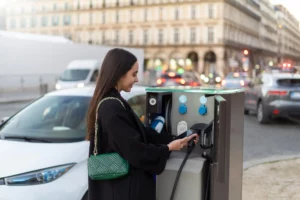
Home / EV Charging News / Is DC fast charging bad for your EV battery?
As electric vehicles (EVs) become more popular, the demand for faster and more efficient charging solutions has grown. One of the most talked-about methods is DC fast charging, which can charge an EV significantly quicker than standard AC charging. However, this rapid charging method raises questions about its impact on the longevity and health of EV batteries. Is DC fast charging bad for your EV battery? This article explores the science behind DC fast charging, its potential effects on battery health, and how to mitigate any negative impacts.
DC fast charging, also known as Level 3 charging, bypasses the onboard charger of an electric vehicle and delivers direct current (DC) directly to the battery. This process allows for much higher power transfer, typically between 50 kW to 350 kW, compared to Level 1 (120V) and Level 2 (240V) AC charging, which offer significantly lower power levels. The result is a much faster charging process, with some vehicles able to gain up to 80% of their charge in 30 minutes or less.
The rapid influx of energy in DC fast charging is what makes it so appealing to EV owners, particularly for long-distance travel or when time is of the essence. However, this speed comes with potential trade-offs that need to be carefully considered.
The primary concern with DC fast charging is its impact on the battery’s health and lifespan. EV batteries are typically made of lithium-ion cells, which are sensitive to various factors including temperature, charging rate, and depth of discharge. Rapid charging can exacerbate these factors, potentially leading to accelerated degradation of the battery cells.
While these concerns are valid, it’s essential to understand that the impact of DC fast charging can vary based on several factors, including the battery’s thermal management system, the frequency of fast charging, and the overall usage patterns of the vehicle.
To ensure that DC fast charging does not significantly harm your EV battery, several strategies can be employed. These strategies focus on optimizing charging habits and taking advantage of advanced battery management systems.
The impact of DC fast charging on battery health is also influenced by ongoing advancements in battery technology. Modern EVs are equipped with sophisticated battery management systems that monitor and regulate the charging process, mitigating some of the negative effects associated with fast charging.
DC fast charging offers a convenient and efficient solution for quickly replenishing your EV’s battery, particularly during long trips or in emergency situations. While it can have some negative effects on battery health, these can be mitigated through careful charging habits and by leveraging advancements in battery technology. By using DC fast charging sparingly, monitoring battery temperature, and taking advantage of modern EV features, drivers can enjoy the benefits of rapid charging without significantly compromising the longevity of their vehicle’s battery. As technology continues to evolve, the gap between convenience and battery health is likely to narrow, making fast charging an even more viable option for EV owners.
